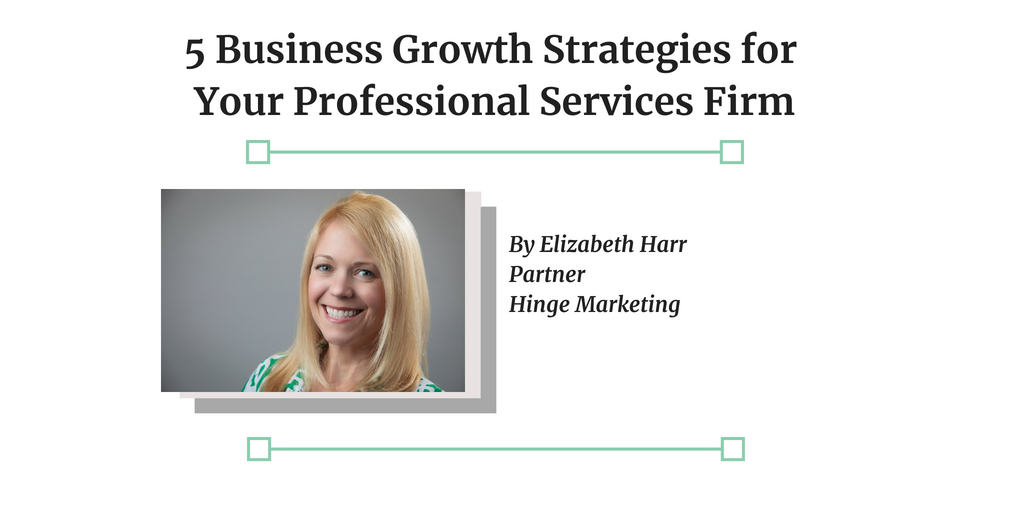
5 Business Growth Strategies for Your Professional Services Firm
By Elizabeth Harr
Partner, Hinge Marketing
Any professional services firm can benefit from developing an intentional and focused business growth strategy. One of the bigger payoffs is that it can help you focus your valuable resources – whether human or capital – and budget where they’ll deliver the biggest bank for your buck.
A business growth strategy describes which industries you’ll serve, the kinds of clients you’ll target, which services you’ll provide and how you’ll position your brand. To be effective, it also has to weigh potential marketplace risks against the expected benefits.
If you already have a business growth strategy and it’s working for you, that’s great. But if not, I’ll share the five most commonly used approaches.
Planning to Grow: 5 Effective Strategies
Depending on your firm’s situation, your ideal business growth strategy may involve varying levels of risk. Below, I describe five of the most time-tested strategies, listed in order from the least to the most risky.
1. Gain Greater Market Penetration
In the professional services world, this approach means offering more services to the same clients. It’s a relatively easy, low-risk strategy — however, it’s not completely without risk. It can be a major challenge to help existing clients understand your full range of services. We know this because of research my firm conducted for our book,
Inside the Buyer’s Brain. The research revealed that most clients are unaware of a provider’s full range of services, and instead tend to think of their services rather narrowly. So, even though there may be plenty of room to increase business revenue from your existing client base, you still have to overcome that mindset – and adjust your marketing of those services accordingly.
2. Create New Markets
In this strategy, you introduce your existing services into a new market. It’s one of the most common growth strategies used by professional services firms. Just be aware that the strategy comes with significant risks. First, it takes money and resources — and the danger of underinvesting in a new market is very real. Shortchange your marketing investment, and you may get poor results. There’s also the risk of diluting your brand: if clients strongly associate you with a particular market, any marketing edge you earned as a specialist could evaporate when you expand into other markets.
3. Develop Alternate Channels for Distribution
For most professional services firms, alternative distribution channels are not easy to find — but they do exist. For instance, you could partner with a business group or trade association to interact directly with its members. Or you could partner with complementary (but non-competitive) service firms to expand your reach. Another option is to use independent “distributors” to offer your services on a “white label” basis. This risks involved in this strategy are mostly about the costs of marketing and business development, and the potential risk to your brand if the new distribution channel you choose is not credible or reliable.
4. Create New Service Offerings
This strategy focuses on developing a completely new but complementary service. Creating new services involves a number of risks. First, it takes a lot of time to develop a new service — which could be a distraction from billable work and business development. Second, there could be regulatory obstacles to overcome. Third, and perhaps most ominous, is the risk that you will water down your brand and begin to be seen as “jack-of-all-trades, master of none.” In seeking broader market recognition, you could become known for nothing at all, without the core area of expertise or focus that made you memorable in the first place.
Other considerations include: Will your market accept you as a provider of the new service, or will it see you new service as more of a conflict of interest? Will it confuse or alienate trusted referral sources? And, regardless of your ability to deliver the new service, will it fit naturally into your current brand and service portfolio, or seem like an afterthought, raising uncomfortable questions for prospective clients?
5. Sell New Services in New Markets
This is arguably the riskiest growth strategy of all, because it compounds the challenges of developing and launching new services by adding the uncertainty and costs of developing a new market. In a word, yikes.
Because of this heightened risk, any opportunity would have to offer the potential of substantial rewards to be worth even considering. For example, you might determine (or receive credible market intelligence) that your existing expertise will be perceived as a unique, high-value solution to a problem in an industry you’ve never marketed to. This approach to growth is definitely possible, if all the conditions are right — but if it sounds unlikely to you, your instincts are probably correct.
Summing up
Figuring out how to grow is a must for every professional services firm. In most cases, firms begin with a handful of existing relationships and referral sources, which they eventually outgrow. But without a formal business growth strategy, the great majority of firms grow only in fits and starts, if at all.
Firms that methodically plan for growth, on the other hand, know just where to look for new opportunities, and at the same time, control their risks. That’s why a growth strategy that is based on systematic analysis and research — and whose level of risk you’re comfortable with — is far more likely to lead to success.
Get your growth strategy right and everything else is easier. Get it wrong or incomplete, and your firm may be headed for challenging times. Good luck to you as you develop your own business growth strategy!
Elizabeth Harr is an accomplished entrepreneur and experienced executive with a background in strategic planning, management, communications, and alliance development. Elizabeth co-founded a Microsoft solutions provider company and grew it into a thriving organization that became known for its expertise in Microsoft customer relationship management.